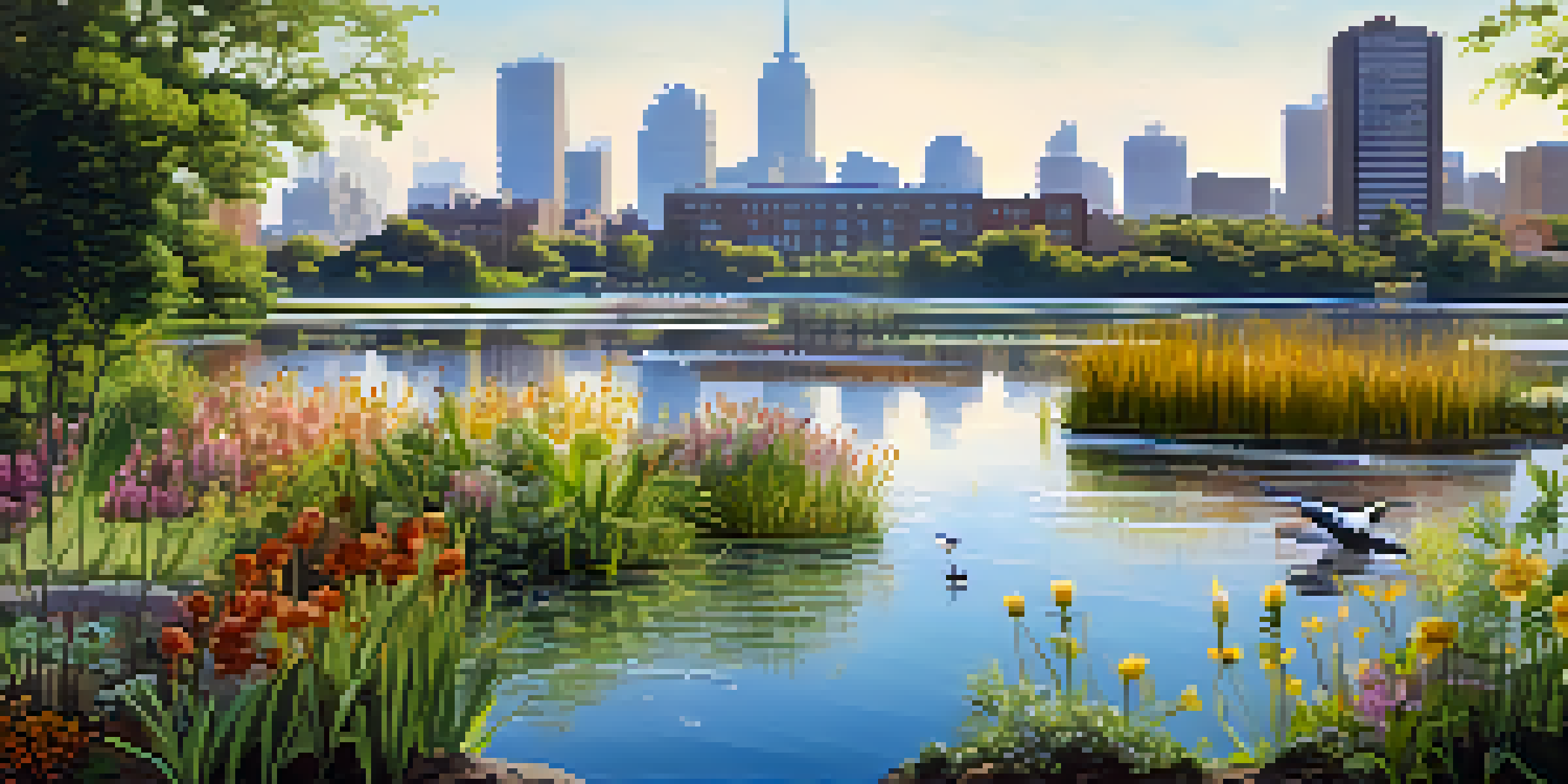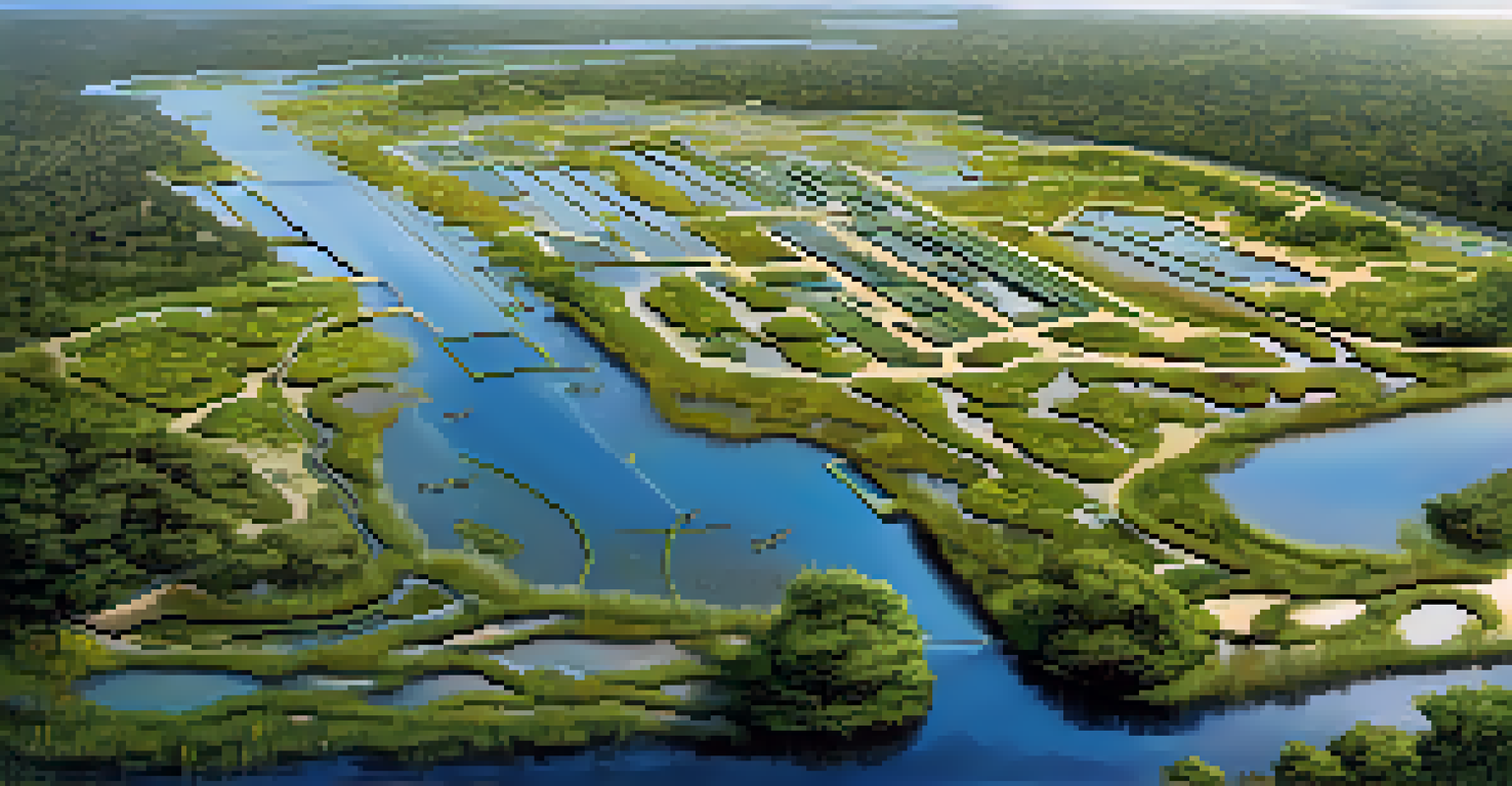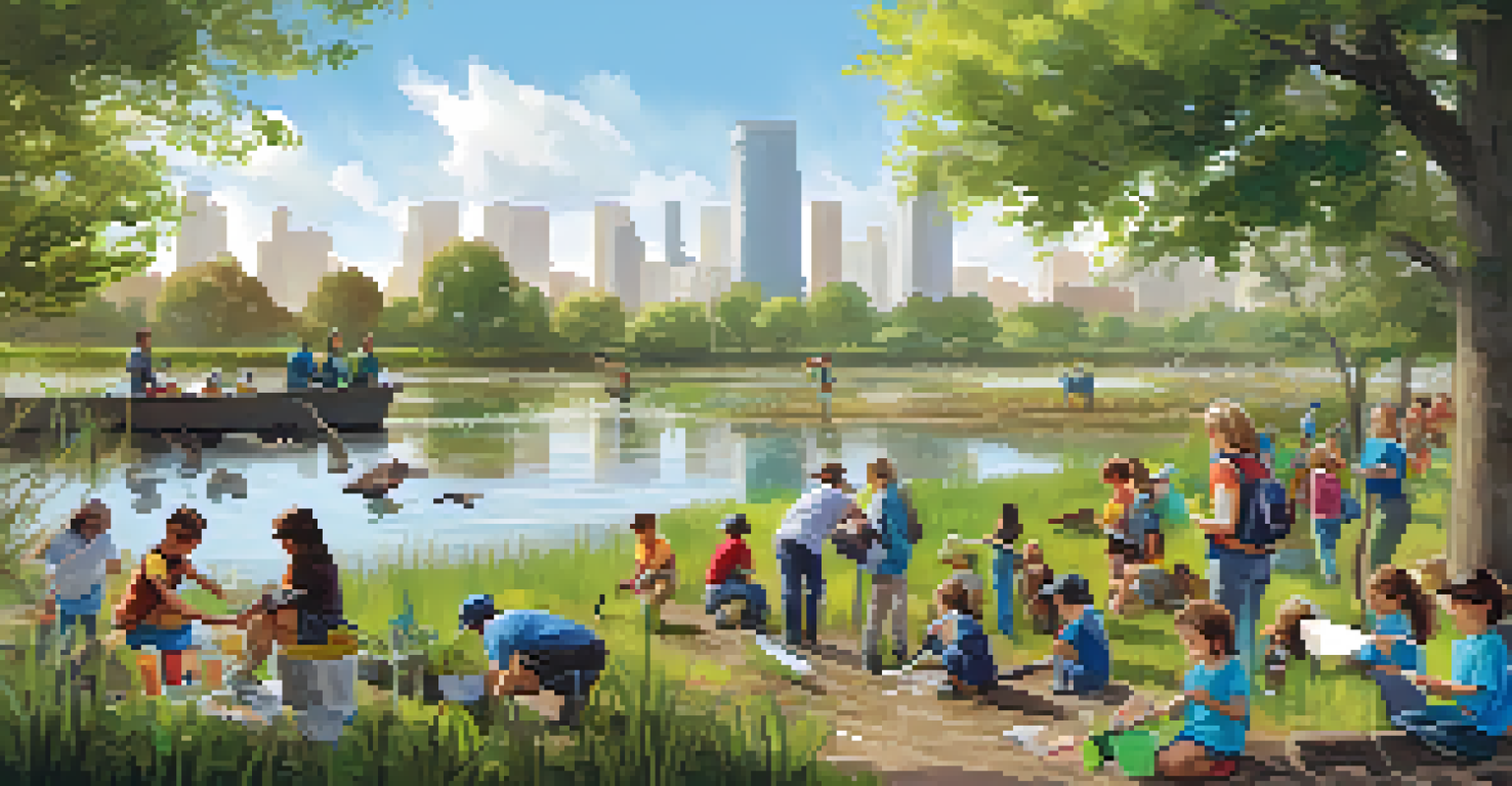The Role of Urban Wetlands in Biodiversity Preservation

Understanding Urban Wetlands and Their Importance
Urban wetlands are unique ecosystems found within city landscapes, often overlooked in discussions about biodiversity. These areas, which include marshes, swamps, and shallow water bodies, play a crucial role in maintaining ecological balance. They serve as natural buffers against flooding, improve water quality, and provide critical habitats for a variety of species.
Wetlands are among the most productive ecosystems in the world, providing essential services to both people and wildlife.
In urban settings, wetlands can be particularly valuable for wildlife, offering refuge amidst the concrete jungle. They help sustain a range of plant and animal life, from migratory birds to amphibians, thus contributing to overall biodiversity. By preserving these habitats, cities can support species that might otherwise struggle to survive in more developed areas.
Furthermore, urban wetlands can enhance the aesthetic value of neighborhoods, providing green spaces for communities. They offer recreational opportunities and serve as educational platforms for residents, fostering a connection between people and nature. Understanding their importance is the first step towards advocating for their preservation.
Biodiversity Benefits of Urban Wetlands
Urban wetlands are biodiversity hotspots that support a wide array of flora and fauna. These ecosystems are home to various species, including fish, birds, insects, and plants, which all play essential roles in the ecological network. The diverse habitats created by wetlands provide food, shelter, and breeding grounds, promoting healthy populations of wildlife.

Moreover, wetlands act as sanctuaries for endangered or migratory species, offering them safe havens in urban environments. For example, certain bird species rely on wetland areas for nesting and feeding during their migrations. By integrating wetlands into urban planning, cities can help ensure that these species continue to thrive.
Urban Wetlands Enhance Biodiversity
These ecosystems provide crucial habitats for various species, contributing to urban biodiversity.
The presence of urban wetlands also positively impacts the surrounding environment by supporting pollinators and other beneficial organisms. This interconnectedness highlights the importance of maintaining biodiversity, as every species plays a role in the ecosystem's health. Protecting urban wetlands ultimately strengthens the entire ecological community.
Wetlands as Natural Flood Management Systems
One of the remarkable features of urban wetlands is their ability to manage stormwater and reduce flooding risks. They act like sponges, absorbing excess rainwater and slowly releasing it, which helps to mitigate flooding during heavy storms. This natural process not only protects urban infrastructure but also reduces the strain on drainage systems.
The future will be shaped by the decisions we make today about how we manage our natural resources, including wetlands.
By slowing down runoff, wetlands also filter pollutants from stormwater, improving water quality in nearby rivers and lakes. The vegetation in these areas traps sediments and absorbs nutrients, preventing harmful substances from entering larger water bodies. This filtering effect is essential for maintaining a healthy urban environment.
Incorporating wetlands into urban planning can lead to more sustainable cities. By recognizing their role in flood management, city planners can create green infrastructure that benefits both people and wildlife. This proactive approach can save municipalities money on flood damage repairs while enhancing community resilience.
Enhancing Climate Resilience through Urban Wetlands
Urban wetlands play a crucial role in climate change adaptation by acting as natural carbon sinks. They capture and store carbon dioxide from the atmosphere, helping to reduce the overall greenhouse gas levels. By preserving and restoring these wetlands, cities can contribute to global efforts to combat climate change.
Additionally, wetlands help maintain local climate stability by regulating temperatures and humidity levels. Their water surfaces can cool the surrounding air, providing a more comfortable environment during hot weather. This cooling effect can be especially beneficial in densely populated urban areas, where heat islands often develop.
Wetlands Mitigate Flood Risks
Acting as natural sponges, urban wetlands absorb excess rainwater, helping to manage stormwater and reduce flooding.
By integrating wetlands into climate action plans, urban areas can create more resilient ecosystems. This approach not only benefits wildlife but also enhances the quality of life for residents. As climate change continues to challenge cities, protecting urban wetlands becomes increasingly vital.
The Role of Community Engagement in Wetland Conservation
Community engagement is essential for the successful conservation of urban wetlands. Local residents can play an active role in preserving these ecosystems by participating in cleanup efforts, educational programs, and advocacy initiatives. When communities are informed about the importance of wetlands, they are more likely to support conservation measures.
Moreover, fostering a sense of ownership among residents can lead to more sustainable practices. Neighborhood groups can organize events to promote the benefits of wetlands, such as birdwatching tours or native plant workshops. These activities not only raise awareness but also create bonds within the community, strengthening collective action toward conservation.
Additionally, engaging with local schools can inspire the next generation to value and protect urban wetlands. Educational programs that focus on the ecological importance of these areas can instill a sense of responsibility in young people. By nurturing an environmentally conscious mindset, communities can ensure that wetlands remain protected for years to come.
Challenges Facing Urban Wetlands Today
Despite their numerous benefits, urban wetlands face significant challenges that threaten their existence. Urban development, pollution, and climate change are just a few factors that can lead to wetland degradation. As cities expand, wetlands are often drained or filled to make way for buildings and infrastructure, resulting in habitat loss.
Pollution from runoff and industrial activities can also harm wetland ecosystems. Contaminants like heavy metals and chemicals can disrupt the delicate balance of these habitats, leading to declines in plant and animal populations. Addressing these issues requires comprehensive policies and community involvement to reduce pollution and restore degraded areas.
Community Action is Key
Engaging local communities in conservation efforts fosters a sense of ownership and promotes sustainable practices.
Climate change poses additional risks, including altered precipitation patterns and rising temperatures. These changes can affect water levels and the overall health of wetland ecosystems. To combat these challenges, it is vital to implement sustainable practices and prioritize wetland conservation efforts in urban planning.
The Future of Urban Wetlands and Biodiversity
Looking ahead, the future of urban wetlands hinges on our collective efforts to protect and restore these vital ecosystems. By integrating wetlands into urban planning and promoting community engagement, cities can create environments that foster biodiversity. This proactive approach will benefit both wildlife and residents, leading to healthier urban spaces.
Innovative solutions like green roofs, bioswales, and constructed wetlands can enhance urban landscapes while supporting biodiversity. These strategies not only help manage stormwater but also provide habitats for various species. By embracing such initiatives, cities can become more resilient and sustainable.

Ultimately, the preservation of urban wetlands is a shared responsibility. By raising awareness and advocating for their protection, we can ensure that these ecosystems thrive for future generations. Together, we can cultivate a harmonious relationship between urban development and biodiversity.